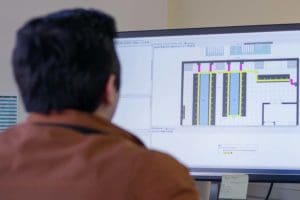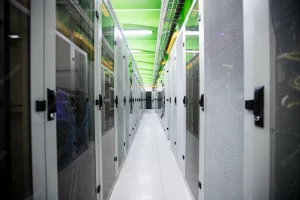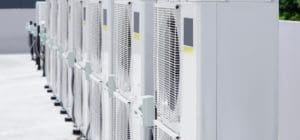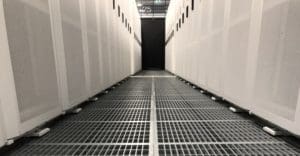Cooling systems are essential for maintaining optimal performance in any data centre, and EziBlank is here to revolutionise your approach to air-flow management. Our innovative solutions, including our premium blanking panels, are designed to enhance the efficiency of your cooling systems while significantly reducing energy consumption. Imagine a more streamlined airflow that not only safeguards your equipment but also maximises your infrastructure investment. With EziBlank, you can optimise your operational performance effortlessly—quickly and easily. Let us elevate your energy management strategy to new heights!
Hot Aisle vs Cold Aisle Containment
Hot aisle and cold aisle containment are two critical strategies used in data centres to enhance cooling efficiency and reduce energy consumption. In a cold aisle containment setup, cold air is contained within the aisle where the fronts of the server racks face each other, ensuring that only cool air is delivered directly to the equipment. This prevents the mixing of cold air with hot exhaust air, improving cooling efficiency. Conversely, hot aisle containment involves enclosing the aisle where the backs of the servers expel hot air. This containment captures and directs the hot air back to the cooling systems, preventing it from mixing with the cool air in the room. Both methods are effective, but the choice between hot and cold aisle containment depends on the specific design and cooling needs of the data centre. Implementing either strategy can lead to significant improvements in energy efficiency and overall system performance.
Read More
Designing an Energy-Efficient Data Center
Designing an energy-efficient data centre requires a strategic approach that combines advanced technology with best practices in layout and infrastructure management. The foundation of an energy-efficient design begins with optimising the physical layout, such as implementing hot and cold aisle containment to prevent the mixing of hot and cold air, which significantly reduces the burden on cooling systems. Incorporating energy-efficient hardware, such as servers and storage devices that consume less power, is also crucial. Additionally, leveraging renewable energy sources like solar or wind power can greatly reduce the carbon footprint of the facility. Effective monitoring and management tools are essential for tracking energy use and making real-time adjustments to improve efficiency. By focusing on these elements, a data centre can achieve optimal performance while minimising energy consumption and operational costs.
Read More
Guide to setting up a Data Center
Setting up a data centre requires careful planning and execution to ensure that the facility meets both current and future needs. The process begins with selecting an appropriate location that offers reliable power, cooling, and connectivity. The physical design of the data centre should incorporate efficient layout strategies, such as hot and cold aisle containment, to optimise airflow and cooling efficiency. Equipping the data centre with scalable infrastructure, including modular server racks and energy-efficient hardware, allows for future growth without major overhauls. Additionally, implementing robust power management systems, such as uninterruptible power supplies (UPS) and backup generators, is critical for ensuring continuous operation. Security measures, both physical and digital, must be in place to protect the data and infrastructure. Finally, ongoing monitoring and maintenance plans should be established to keep the data centre operating at peak performance. By following this guide, you can set up a data centre that is efficient, secure, and scalable.
Read More
Data Center Cooling: Best Practices
Implementing best practices for data centre cooling is crucial to maintaining efficiency, reducing energy costs, and ensuring the longevity of equipment. Key practices include optimising airflow by using blanking panels to fill unused rack spaces, which prevents hot air recirculation and ensures that cool air reaches the servers effectively. Additionally, employing hot and cold aisle containment systems can further enhance cooling efficiency by separating hot exhaust air from cold intake air, reducing the workload on cooling systems. Regular maintenance of HVAC systems and air filters is essential to ensure that cooling units operate at peak performance. Monitoring temperature and humidity levels in real-time allows for adjustments that prevent overheating and ensure optimal conditions. By following these best practices, data centres can achieve significant improvements in cooling efficiency, leading to lower operational costs and improved equipment performance.
Read More
How to Manage Airflow in a Data Center
Managing airflow in a data centre is crucial for maintaining optimal cooling efficiency and ensuring the longevity of equipment. Effective airflow management begins with the strategic placement of blanking panels in server racks to eliminate gaps, which prevents hot air from recirculating and ensures that cool air is directed precisely where it’s needed. Implementing hot and cold aisle containment systems further enhances airflow by separating the hot exhaust air from the cool intake air, reducing the workload on cooling systems. Proper cable management is also essential to avoid obstructions that can disrupt airflow patterns. Additionally, using perforated floor tiles in the raised floor environment helps channel cool air directly to the servers. Regular monitoring and adjustments based on real-time data are necessary to maintain efficient airflow and adapt to changes in the data centre’s layout or load. These strategies collectively help optimise cooling, reduce energy consumption, and improve the overall performance of the data centre.
Read More
The 411 on CRAC Units
Computer Room Air Conditioning (CRAC) units are essential components in data centre cooling systems, designed to maintain optimal temperature and humidity levels for sensitive IT equipment. These units work by drawing warm air from the data centre, cooling it, and then distributing the chilled air back into the room, ensuring that servers and other hardware operate within safe temperature ranges. CRAC units often feature precise controls to maintain consistent environmental conditions, which is crucial for preventing overheating and ensuring the longevity of equipment. Incorporating CRAC units into a data centre's cooling strategy, along with effective airflow management techniques like blanking panels and aisle containment, helps improve overall cooling efficiency and reduce energy consumption.
Read More
High performance directional floor tiles for high density equipment racks
High-performance directional floor tiles are a critical component in data centre design, specifically engineered to optimise airflow and cooling efficiency. These tiles are strategically placed within raised floor systems to direct cool air from the underfloor plenum towards the server racks, ensuring that the air reaches the equipment that needs it most. By guiding airflow precisely, directional floor tiles help maintain consistent temperatures across the data centre, prevent hotspots, and reduce the workload on cooling systems. This leads to more efficient cooling, lower energy consumption, and improved overall performance of the data centre. Incorporating these tiles into a data centre's design is an effective way to enhance both energy efficiency and operational reliability.
Read More
